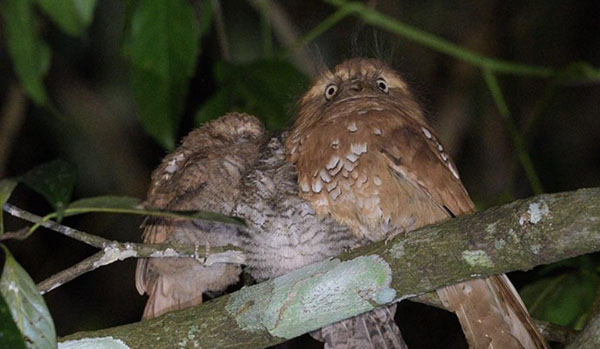Batrachostomus hodgsoni
IUCN
LCBasic Information
Scientific classification
- name:Batrachostomus hodgsoni
- Scientific Name:Batrachostomus hodgsoni,Black-capped Frogmouth, Black-capped Frogmouth, Old Fearful,Batrachostomus hodgsoni hodgsoni
- Outline:Climbing birds
- Family:Nighthawks Frogmouth
Vital signs
- length:About 24 cm
- Weight:
- lifetime:14years
Feature
It has a wide mouth and is the only frog-mouthed owl in China.
Distribution and Habitat
There are records in Yunnan, China. Abroad, it is distributed in India, Bangladesh, Indochina, etc.
It mainly inhabits evergreen broad-leaved forests, secondary forests and forest edge shrub areas below 2,000 meters, especially steep valleys with sparse trees.
Appearance
The bill is broad and thick, with a curved upper bill and a hooked tip. The base of the bill has long whisker-like feathers. There is a white collar on the back of the neck. The tail is long and convex. The male has a short white eyebrow and the whole body is mottled with black-brown, brown-red and white. The female has a brown upper body and a white throat. There are large white spots on the chest and shoulders. The iris is orange-yellow, the beak is yellow, and the feet are flesh-colored.
Details
The body shape of the Black-capped Frogmouth is similar to that of a nighthawk. However, the beak is wide, and the upper beak is very curved with a hooked tip. The whiskers on the forehead and head are very developed, and the nostrils are covered by whiskers, which distinguishes it from birds of the family Nighthawk.
The Black-capped Frogmouth is a dusk hunter and a night elf, but it is a complete "lazy bug" during the day. This "reversed jet lag" lifestyle is because all nighthawks are "night owls". Most of them start foraging at dusk, and some people have seen them successfully catching insects in the air. Compared with the activeness at dusk and night, the Black-capped Frogmouth often hides in the dense branches of trees or bushes during the day to sleep, as shown in the photo. However, don't think that the Black-capped Frogmouth is "sleeping to death". In fact, it is always vigilant and will "run away" as soon as there is any sign of trouble.

In Yunnan, the black-capped frogmouthed nightjar is called "Old Fear" by people. Especially when children are noisy and don't sleep at night, adults often scare them and say: "If you don't behave, be careful that 'Old Fear' will come to you at night." In general, children will be scared and go to bed obediently.
The nickname "Old Fear" full of Yunnan flavor comes from the beak of the black-capped frogmouth. Unlike other birds with long and pointed beaks (a general term for bird beaks), the beak of the black-capped frogmouth is shorter, but has an exaggerated width. When it opens its beak, it looks like the big mouth of a toad or frog. In addition, its nocturnal habits make it the prototype of the folk horror element "Old Fear".
Although the nickname is not nice, the black-capped frogmouth is definitely a friend of humans. It can eliminate most types of pests such as moths and locusts. However, due to frequent human activities and the destruction of its habitat, it is now difficult to see the black-capped frogmouth in the wild.
Often active alone or in pairs. It is nocturnal and hides in dense forests during the day. It lies or stands on the horizontal branches of large tree trunks. Because its body color is similar to that of branches, it is generally difficult to find without paying attention. Sometimes it perches on small branches in an upright posture. It starts to move and hunt at night and dusk. It flies lightly and silently. It mainly feeds on insects and also eats small rodents.

The breeding season is mainly from April to June, the earliest in late March and the latest in late August. It usually nests in mountain forests at an altitude of 400-2000 meters, especially in steep mountain valleys. The nests are mostly placed on the horizontal branches of small trees, 1.5-5 meters above the ground. The nests are made entirely of down feathers and fine feathers that the female bird plucks from her abdomen. The size is 6-9 cm in diameter and 2 cm deep, with a slight concave in the middle. The nesting materials are mostly deeply inserted into the cracks of the bark, and the outside of the nest is fixed tightly together with mosses, lichens and spider egg bags, so the nest is not only quite strong, but also looks like a tumor-like protrusion growing on the tree itself. Each nest usually lays 2 eggs, sometimes as few as 1. The eggs are white, smooth and spotless, long oval or oval, and the size is 24.4-28.1 mm × 16.3-19.5 mm, with an average of 26.5 mm × 17.6 mm. The male and female parents take turns to incubate the eggs. The male usually incubates the eggs during the day and the female at night. The chicks are late-maturing.








